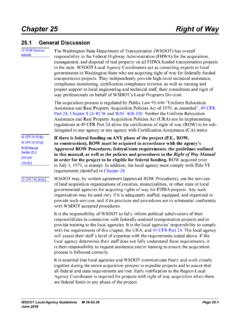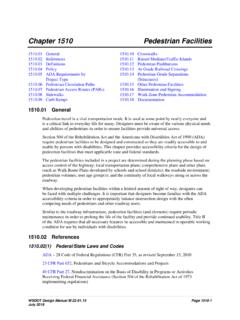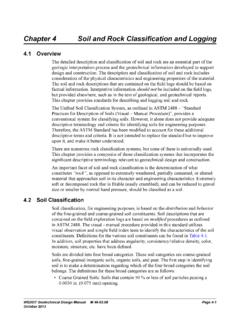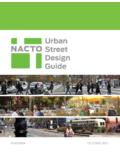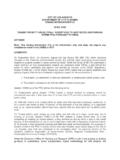Transcription of Chapter 1430 Transit Facilities
1 WSDOT design Manual M Page 1430-1 November 2015 Chapter 1430 Transit Facilities General Bus Stops and Pullouts Passenger Amenities Park and Ride Lots Transfer/ Transit Centers Roadway and Intersection design Documentation References General This Chapter provides general siting and design information for Transit Facilities . It is intended for Washington State Department of Transportation (WSDOT) engineering and planning staff, local Transit providers, developers, and local agencies engaged in the collaborative development of Transit Facilities on or adjacent to state highways. The main points covered in this Chapter are: bus stop Policy: WSDOT s policy for developing bus stops on state highways is presented.
2 The policy calls for WSDOT and the Transit provider to work together to locate stops on state highways. bus stop placement considerations are also provided. Park and Ride Lots: Basic guidelines for development of park and ride lots are presented. Transit /Transfer Centers: Guidance on these centers is provided. Guidance in the Park and Ride section may apply as well. Universal Access: T he requirements of the Americans with Disabilities Act (ADA) apply to bus stops and shelters, park and ride lots, and Transit centers. This information is presented in various sections of the Chapter , with additional references provided. Tools and Resources: Additional guidance and criteria are recommended and referenced, such as: other chapters in the design Manual for designing intersections and road approaches; the Roadside Manual for parking lot design ; the local Transit authority s own standards; and AASHTO.
3 The design and planning information that follows supports the development of public Transit infrastructure and services on state highways. design Manual topics and chapters commonly used in conjunction with this Chapter include: Right of way and access control: Chapters 510 through 560. Intersections and road approaches: Chapters 1300 through 1370. Americans with Disabilities Act (ADA) and sidewalk design : Chapter 1510. High-occupancy vehicle (HOV) Facilities : Chapters 1410 and 1420. Transit Facilities Chapter 1430 Page 1430-2 WSDOT design Manual M November 2015 Bus Stops and Pullouts WSDOT s Modal Integration Goal seeks to optimize existing system capacity through better interconnectivity of all transportation modes.
4 In support of this goal, WSDOT promotes safe and efficient public transportation services on state highways, including Transit routes and stops. On limited access Facilities , bus stops are only allowed at designated locations, such as flyer stops. (See Chapters 520, 530, and 540 for access control policy and guidance.) Bus stops may be approved on non-limited access Facilities at the Transit agency s request and upon formal review by WSDOT for sight distance and universal access requirements at the proposed location. At a Transit agency s option, a bus stop on these highways may be located either within the travel lane, or outside the travel lane in a pullout. Contact the State Traffic Engineer for information on how to process a Transit agency proposal for either an in-lane or pullout bus stop and for more information about the approval process.
5 Refer to WAC 468-46, Transit Vehicle Stop Zones, for additional details. The bus stop is the point of contact between the passenger and the Transit services. The simplest bus stop is a location by the side of the road. The highest quality bus stop is an area that provides passenger amenities and protection from the weather. Bus stops are typically maintained by the Transit agency. The bus boarding and alighting pad, the path to the shelter, and the area within the shelter must meet the requirements for universal access. Coordinate with the local Transit agency regarding the location and what type of bus stop to use. For additional information on bus stop treatments, see Understanding Flexibility in Transportation design Washington and the Transit agency s standards for treatment.
6 (1) bus stop Placement Guidelines The information in this section is offered as an example of good practice, and is not intended to be binding by either the Transit agency or WSDOT. Placement of bus stops addresses the needs and convenience of Transit providers, riders, and highway or street operations. Basic considerations include: The need for safe, secure, and convenient service for patrons Access for people with disabilities Convenient passenger transfers to other intersecting bus routes or transfer points Connection to nearby pedestrian circulation systems Presence and width of sidewalks, crosswalks, and curb ramps Pedestrian activity through intersections Ability of the stop to accommodate Transit dwell time and the loading/unloading of wheel chairs and bicycles Adequate curb space for the number of buses expected at the stop at one time Ease of reentering traffic stream (if a pullout)
7 design characteristics and operational considerations of the highway or street Presence of on-street automobile parking and truck delivery zones Traffic control devices near the bus stop , such as signals or stop signs Volumes and turning movements of other traffic, including bicycles Chapter 1430 Transit Facilities WSDOT design Manual M Page 1430-3 November 2015 Proximity and traffic volumes of nearby driveways Street grade Proximity to rail crossings Accommodating Transit priority equipment at signalized intersections Transit queue bypass at signalized intersections Often stops are paired on each side of a highway or street Proximity to intersections Where blocks are exceptionally long or where bus patrons are concentrated well away from intersections, midblock bus stops and midblock crosswalks may be beneficial.
8 Contact the Region Traffic Engineer when a midblock bus stop is being considered on a multilane roadway to determine crossing design details and treatments that may be required. (See Chapter 1510 and the Traffic Manual for more information on midblock crossings.) It is common to clearly mark the bus stop as a NO PARKING zone or as a BUS ONLY zone with signs and/or curb painting. The remainder of this section discusses three types of bus stops: Far-side, with a stop located just past an intersection Near-side, with a stop located just prior to an intersection Midblock, with a stop located away from an intersection Exhibit 1430-1 illustrates these three types of stops and provides some general dimensions.
9 Consult the AASHTO Guide for Geometric design of Transit Facilities on Highways and Streets for additional guidelines on bus stop spacing, including information on these types of stops. Examine each case separately and determine the most suitable location, giving consideration to service and safety of patrons, efficiency of Transit operations, and traffic operation in general. (1)(a) Far-Side Bus Stops Sight distance conditions generally favor far-side bus stops, especially at unsignalized intersections. A driver approaching a cross street on the through lanes can see any vehicles approaching from the right. With near-side stops, the view to the right may be blocked by a stopped bus.
10 Where the intersection is signalized, the bus may block the view of one of the signal heads. Advantages: Right turns can be accommodated with less conflict. Minimum interference is caused at locations where traffic is heavier on the approach side of the intersection. Stopped buses do not obstruct sight distance for vehicles entering or crossing from a side street. At a signalized intersection, buses can often find a gap to enter the traffic stream, except where there are heavy turning movements onto the street with the bus route. Waiting passengers assemble at less-crowded sections of the sidewalk away from the intersection corners. Buses in the bus stop do not obscure traffic control devices or pedestrian movements at the intersection.
